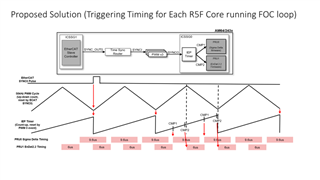Hi team,
Could help my customer's questions on below system configurations?
-
Customer used to use C2000's F2812 or F28335, when using UART peripherals, receiving data is received by using interrupts, byte by byte, and the efficiency is relatively low. Does AM243X have UART receive timeout interrupt or receive complete interrupt? If yes, can you provide a reference code?
-
Set up a local timer interrupt, how can the interrupt be synchronized with the ethercat bus SYNC? Can an IO input port latch the timer count value? If so, which peripherals should be used to implement it?
-
The bus SYNC signal can be synchronized with PWM, SINC and encoder, so can PWM, SINC and encoder be synchronized with the input of a certain IO port? If so, which peripherals should be used to implement it?
-
A certain project runs in R5-0-0, how to change it to run in R5-0-1? Can you use "cdc_echo_nortos_am243x-lp_r5fss0-0_nortos_" in the SDK to explain how to modify it to run in R5-0-1?
-
Some sample codes will directly call the source code in the SDK. How to view the corresponding source code in CCS conveniently and quickly?
-
AM243X supports BISS-C, ENDAT and TAMAGAWA encoders, but is it supported to use the same pins? That is, the fixed pins of the processor are connected to RS485, and the switching of the above three encoder functions can be realized through software settings?
At present, in our products, the above three encoder interface functions are implemented in the FPGA. When the interface function is switched, there is no need to change the hardware circuit. - When transplanting the CDC example (cdc_echo_nortos) in other SDK examples (such as uart_echo_low_latency_interrupt), the following 2 MPUs must be added, otherwise the program will run away. What is the reason?




